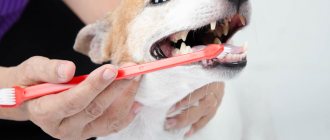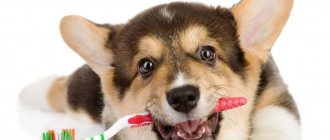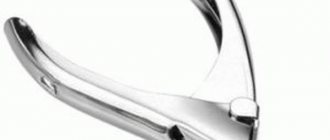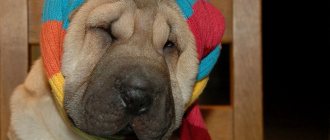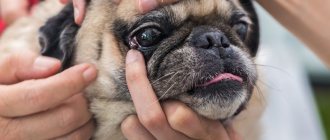Vaccination protects against infections that can lead to the death of the animal. These include several diseases, in particular rabies and leptospirosis, which are also dangerous to humans. But the dog owner does not always have the opportunity to visit a veterinary clinic. In such cases, you need to know how to vaccinate your dog yourself in order to protect it from dangerous viruses and bacteria.
Vaccinations protect against rabies and other infections
Vaccination schedule
Vaccination is carried out according to a specific schedule.
Table 1. Recommended vaccination schedule for dogs
| 8-9 weeks | Vaccination against canine distemper, parvovirus enteritis, infectious hepatitis, adenovirus infection, parainfluenza, leptospirosis. |
| 12 weeks | Revaccination against canine distemper, parvovirus enteritis, infectious hepatitis, adenovirus infection, parainfluenza, leptospirosis, rabies. |
| After changing teeth | Vaccination against canine distemper, parvovirus enteritis, infectious hepatitis, adenovirus infection, parainfluenza, leptospirosis, rabies. |
| 1 year | Vaccination against canine distemper, parvovirus enteritis, infectious hepatitis, adenovirus infection, parainfluenza, leptospirosis, rabies. |
| Annually | Revaccination (canine distemper, parvovirus enteritis, infectious hepatitis, adenovirus infection, parainfluenza, leptospirosis, rabies). |
Attention! Some manufacturers produce vaccines that guarantee protection of the animal from viruses and infections for 3 years. Accordingly, they are administered once every 3 years.
Vaccination is carried out according to a specific schedule
In Russia, dogs are vaccinated against borreliosis and bordetellosis, the causative agents of tracheobronchitis (CB). Whether they are needed is decided by the doctor based on data on the epidemiological situation in the region.
The most common and dangerous diseases that dogs can get
The disadvantage of vaccinations at home is that this fact is not noted in documents - veterinary passports and specialized registers. Therefore, if we are talking about an animal that will travel or take part in exhibitions, then the procedure is carried out in a veterinary clinic. Previously, according to the law, rabies vaccinations were allowed only in government clinics. Now private veterinary clinics are also given such powers.
It has not been proven that vaccination can protect a dog from shingles.
Dogs are also vaccinated against other diseases - parasitic infestations, coronavirus, lichen. But their effectiveness is either low or not proven.
Attention! When choosing a drug, remember its name and manufacturer. Veterinarians recommend vaccinating an animal with the same vaccine throughout its life.
Vaccines
In veterinary practice, the following brands of vaccines are used to vaccinate dogs:
- Nobivac;
- Duramun;
- Eurikan;
- Biovac;
- Dipentavak;
- Asterion;
- Multikan and others.
Basically, these are complex products that contain causative agents of major infections, some of them including the rabies virus. The latter include Asterion DHPPiR, Multikan-8.
Attention! Not all domestic vaccines are recognized abroad. Therefore, it is necessary to consult a veterinarian about the drug if you are planning a trip accompanied by an animal.
Decoding the letter values in the names of the product
Vaccines are either live or inactivated. Not all specialists use inactivated products. According to some doctors, they provide weaker immune protection, so preference should be given to “live” formulations.
How the vaccine is administered
It is better to get vaccinated in the morning on a day off. This makes it possible to monitor the dog’s condition all day long.
You can read about how to prepare your dog for vaccination, what to do if complications arise and where is the best place to vaccinate in our article.
Typically, the kit includes two products: the vaccine itself in powder form and a solvent for it. The components are first mixed. To do this, draw up the solvent with a syringe, and then inject it with a needle through the lid into the container with the powder. The mixture is thoroughly shaken until all dry particles are dissolved. Select the injection site:
- subcutaneously - withers area;
- intramuscularly - thigh area.
Place of injection - withers area
Next, the drug is administered into the dog’s body in the following order:
- treat the injection site (if necessary, cut it with scissors);
- wipe the injection site with medical alcohol;
- immobilize the animal using a special bag, towel, or ask another family member to hold it;
- if the injection is given at the withers, a fold of skin is collected on this part, into the base of which a needle is inserted;
- the drug is infused;
- remove the syringe;
- wipe the injection site with alcohol.
The instructions for some drugs say that the injection site must be massaged. More precise instructions regarding the rules and method of administration should be sought in the manufacturer's instructions.
Intranasal vaccines (for example, Nobivac KS) are administered into the nostril. Then the drug is poured into the nasal passage.
Video - How the vaccine is administered
The vaccine should not be used in the following cases:
- bottles or caps are damaged;
- the product has expired;
- the liquid or powder looks different from the description in the instructions.
Personal safety measures
The vaccine spilled on the body is washed off with plenty of running water. If a veterinary drug is accidentally administered to a person, then in such cases, immediately consult a doctor. The specialist is presented with a factory-made vaccine bottle.
Any drug that gets on the skin is washed off with plenty of running water.
The drugs are stored in places inaccessible to children. After use, the product is immediately discarded so as to prevent other animals or people from reaching the containers and used syringes.
First vaccination
The first vaccine is administered twice, regardless of the dog’s age, according to the following scheme:
- Anthelmintic drug - 2 times with an interval of 2 weeks.
- The first vaccination is after 1.5-2 weeks of the second dose of anthelmintic.
- The second vaccination is 3 weeks after the first.
Attention! Re-vaccination is carried out with the same drug with the same quantity and qualitative composition of strains. Using another drug may be dangerous to your pet's health.
Contraindications to vaccination
Vaccinations are given when the dog is healthy. This is important because vaccination puts a strain on the immune system. The body must respond correctly to the substance and fully produce antibodies.
Vaccinations are prohibited for dogs with the following conditions:
- infection with worms;
- illness, including one suffered shortly before;
- exhaustion;
- change of teeth in a puppy.
Also, you cannot plan to administer the vaccine 2 weeks before and after the cupping procedure.
Attention! The body must first be cleared of worms. Dogs are given medications two weeks before vaccination. Parasites reduce the effectiveness of the drug to zero.
Parasites are expelled before vaccination
Another contraindication is previous vaccination. The next one can be carried out no earlier than after 3 weeks.
If on the day of vaccination or one or two days before, the owner notices alarming symptoms in the pet, digestive disorders, changes in behavior, the procedure is postponed.
Types of injections
Medicines, depending on the place of administration, are of two types:
- for intramuscular injections (i.m.);
- for subcutaneous injections (s.c.).
Of course, you can also find medications that are used intravenously, but the use of such drugs for dogs is unacceptable (for the reason that such injections will either end the animal’s life or are already meaningless, since it only has a few days left to live). Therefore, it is common for dogs to use intramuscular and subcutaneous injections.
Pregnancy and lactation
It is recommended that your dog be vaccinated before pregnancy occurs. It is possible that vaccine components can penetrate the placenta and cause fetal death or developmental defects. If such a measure is necessary, it is recommended to use only inactivated drugs, which are selected by the veterinarian.
It makes no sense to vaccinate a nursing bitch to protect the offspring. In order for puppies to acquire passive immunity, the female’s body must begin to produce antibodies. To do this, at least a week must pass after the procedure. Antibodies are obtained from the mother through colostrum in the first 36 hours of the offspring's life.
It is better to vaccinate a bitch before pregnancy.
Intravenous injection through a catheter
This method is considered the most effective in intensive care, and this is the main advantage. However, without a catheter installed in the dog’s body, it is quite difficult to do this yourself, without special skills.
If the dog is undergoing treatment and a catheter is installed in the paw for administration, the task is simplified. Before injecting the medicine, make sure that the device has not moved and is in the blood vessel. This is tested by injecting a small dose of sodium chloride solution. If the piston moves tightly, and a swelling forms near the place where the device is installed, then the drug cannot be injected. You need to replace the catheter first.
It is convenient to infuse medications through a catheter
The cap is removed from the catheter and a syringe with saline solution is attached to it. To flush, pour 2-3 ml of solution into the hole, and another 2-3 drops into the port. Then connect a syringe filled with medication and slowly inject the drug.
Attention! Medicines are administered very slowly. A high rate of drug administration may subsequently cause vomiting in the animal.
After each injection, the device is washed with saline solution.
Video - How to administer drugs intravenously to animals through a catheter
Features of puppy vaccination
Puppies that are breastfed acquire passive immunity from their mother, provided that she is vaccinated in a timely manner. The female passes antibodies to infections to the cubs with her milk. The time of the first vaccination depends on the quality of the mother's lactation. If there are few puppies, then vaccination is carried out no earlier than 10 weeks. Earlier introduction of complementary foods and a large litter are grounds for vaccination at an earlier age.
Puppies receive passive immunity from their vaccinated mother
Monitoring the dog's condition
After vaccination, it is necessary to monitor the animal’s condition for 2 weeks.
Some discomfort is considered normal
The following phenomena are considered normal:
- A lump or lump in the place where the drug was injected. The formation resolves within a month. If the lump increases in size, then this is a reason to consult a doctor.
- Vomiting, diarrhea, refusal to eat, if these phenomena were recorded once.
- Pain at the injection site.
- Lethargy, fever up to 39 °C.
How to give an injection in the withers of a small, emaciated dog or puppy
Recommendations for small, malnourished dogs or puppies are practically no different. The only nuance is the size of the syringe and the depth of needle insertion. The safest and most painless option is insulin. It has the thinnest and shortest needle. Due to the short length, in most cases it is inserted to the end, but for the listed animals the depth can be reduced to half.
At the time of injection, be sure to keep the coat dry. If it gets wet, the selected depth is not sufficient to pierce the skin. In this case, you need to enter it a little further.
Complications from vaccination
You should immediately contact your veterinarian in the following cases:
- loose stools and vomiting after administration of the drug were observed 2 or more times;
- the dog missed more than one meal;
- temperature above 39 °C;
- convulsions and drooling appeared;
- mucous membranes turned pale;
- swelling is noticeable;
- breathing became difficult and quickened.
Prolonged refusal to eat is a cause for concern
A painful reaction is provoked by various factors. Poor quality vaccine is one of them.
Allergy to the drug
An acute attack of allergy is observed in a dog 10–15 minutes after administration of the drug. This is the most dangerous reaction to the vaccine. The following symptoms may occur:
- behavior is disrupted - the animal becomes too excited or depressed;
- head temperature rises;
- the dog may suddenly relieve itself;
- the muzzle swells - eyes, nose, ears;
- saliva is produced abundantly;
- watery eyes or nasal discharge appears.
After administration of the drug, an acute allergic reaction is possible
You should always be prepared for such a reaction. Therefore, it is a good idea to ask your veterinarian which drug and in what dose should be administered in such cases. For severe allergies, solutions of Tavegil, Andrenalin or Suprastin are used. In case of anaphylactic shock, Dexamethasone is recommended, after which the pet is immediately shown to a doctor.
Video - Complication in a kitten after vaccination
To avoid an allergic reaction, the solution is administered fractionally: first a small dose, then the remaining drug in the syringe. Then the antibodies bind to a smaller portion of the solution, thereby reducing the severity of the reaction.
Preparation for the procedure
The effectiveness of the procedure largely depends on preparation. It includes choosing a medication, calculating the dosage, purchasing tools, finding a comfortable place and calming the dog.
Selection and dosage of the drug, its preparation
The drug and its dosage are selected by the veterinarian based on the tests of the four-legged patient. Medicines intended for other types of injections can cause allergies, burns and even tissue death.
Please note that large doses are administered several times to different areas of the scruff of the neck. This reduces the likelihood of bruising and irritation.
Recommendations for preparing the drug are also provided by the doctor, but you can also read them in the instructions for use. Some substances require shaking, others require mixing.
If the medicine is stored in the refrigerator, it is necessary to warm it up to 37 ° C, since the administration of cold liquid is very painful. The final temperature should be no higher than this mark, the minimum acceptable temperature being room temperature. If you have time, just leave the bottle on the table, and if not, warm it in your hands or warm (not hot) water.
Weighing the animal
The weight of the animal affects the dosage. If you are not sure about this parameter, weigh your pet so as not to inject him more or less than the recommended amount.
Buying a syringe and needle
Here you should also rely on medical recommendations. The size of the syringe and needle is selected based on the following factors:
- Animal size. The insulin type is suitable for small breeds, and at least 3 ml in volume for large breeds. Special attention should be paid to thick-skinned quadrupeds. Thin needles are not suitable for them, as they very often break even at the moment of insertion.
- Pet's age. Puppies are injected only with insulin syringes, regardless of their breed.
- Amount of drug administered. Despite the painlessness, the procedure is still unpleasant from a moral point of view. The sooner it ends, the better. For this reason, large dosages are administered in one go with a 5 ml syringe. It comes with a fairly thick needle, but it can be replaced with a thinner one.
- If your pet is very active and fidgety, it is better to purchase a butterfly needle or an IV needle. The wire on the needle will protect it from jumping out even when the dog is too restless.
- Features of the medicinal substance. Oily solutions are not suitable for insulin varieties. They quickly clog their thin needles, so in this case it is safer to choose larger options from 3 ml.
Another important point is the presence of rubber on the piston. It slows down the insertion process, reducing the risk of pain.
Preparing the place
Large animals are placed directly on the floor in a sitting position or placed on their side with their paws extended. It is difficult to reach the scruff of small pets in this position, so they are placed on a flat, non-slip hill.
To prevent bites, use a muzzle. If your pet weighs no more than 10 kg, purchase a retainer bag. She leaves only the paws and head free, greatly facilitating the procedure. For puppies and toy dogs, this bag can be replaced by a cocoon made of thick fabric.
Psychological state of the pet
Avoid coercion by using force and yelling. Active suppression of a resisting pet is fraught with retaliatory aggression and the formation of a strong fear of the procedure in the future.
During manipulations, be sure to talk to your pet in a calm and confident voice. Dogs are unusually smart animals; they often agree to endure for the sake of their owner.
If you have to work with an incorrigible coward, enlist the support of one more person. Otherwise, attempts to escape may result in the needle breaking off and getting stuck.
Quarantine after the vaccine
After receiving the vaccine, the dog is kept in quarantine for 10–14 days to develop lasting immunity. They don’t refuse walks. But their duration is reduced to the minimum necessary, especially in unfavorable weather conditions, in order to prevent hypothermia. They try to exclude contacts with other animals, in particular stray ones. Physical activity is also limited.
Don't miss a walk during quarantine
How to store the vaccine
When purchasing a drug, you must ask the pharmacy seller to provide instructions for it. Optimal storage conditions are indicated there.
Attention! The effectiveness of the procedure depends on whether the recommendations are followed. A vaccine that has been stored without temperature control is unsuitable for use.
Most of these products are stored at a temperature of 2...8 °C. Freezing ampoules is prohibited, since the properties are lost in the same way as when heated. To deliver the drug from the veterinary pharmacy to your home, special thermal container bags are used. Such products are on sale. Some pharmacies rent bags with a deposit. To ensure the safety of the drug, some kind of refrigerant is placed inside - “dry ice”, ice cream, a bottle of frozen water.
Special container bags are used for delivery
A low-quality vaccine is always dangerous. In the “best” case, it will turn out to be plain water without a therapeutic effect. This will not harm the animal, but the body will not receive immunity to the infection. In the worst case, it will cause an allergic reaction and lead to death.
Injection errors
One of the most common mistakes is a poorly secured needle. The needle “shoots” when the plunger of the syringe is pressed. This happens especially often if viscous liquids are administered - for example, oil vitamins, antibacterial drugs, etc.
People who have not injected before may insert the needle too deeply and pierce the skin fold all the way through. To prevent this from happening, the injection is made not at the top of the resulting triangle, but almost at its very base.
Correct and incorrect direction of injection
Another mistake is using a blunt instrument. Very often, one needle is used to pierce the cap of a bottle of medicine and for subsequent administration of the drug. This is not necessary because the animal will experience more pain than usual. To ensure that the injection brings minimal discomfort, two needles should be used. Veterinarians also do not recommend mixing two drugs in one syringe.
Attention! Not all medications are compatible. Injecting different medications from the same syringe can lead to an allergic reaction in a dog.
Video - How to dissolve powder preparations
Infection of a vaccinated animal
Vaccination does not provide a 100% guarantee that the vaccinated animal will not get sick. Infection occurs for the following reasons:
- low quality vaccine used;
- the storage conditions of the drug were violated;
- the solution was introduced incorrectly;
- the effect of the vaccine is suppressed by antibodies contained in the mother’s milk;
- there are other diseases, especially those associated with decreased immunity;
- the animal is infected with a large dose of the pathogen, the likelihood of such a scenario increases if this happened during the formation of immunity);
- the disease developed before immunity was formed.
However, such adverse events are rarely recorded.
Vaccination notes in the veterinary passport
When to start vaccinating
Until the age of two months, dogs have immunity acquired through mother's milk; your pet should not be vaccinated before this period. When he gets older, his immunity becomes weaker, then the first vaccinations are given. It is worth considering that by the age of 16 weeks, dogs already begin to change their teeth; it is necessary to vaccinate your pet before this period. If you vaccinate your pet during a tooth change, when the body is weakened, the animal will not be able to cope with the microdose of the pathogen contained in the vaccine and will become seriously ill. To ensure that the pet pleases its owners with its health and good mood, vaccination of puppies at two months of age is the best time to strengthen the immune system.
Re-vaccination of dogs is necessary based on the breed, the general health of the pet and the instructions available for each individual vaccine. The veterinarian will accurately determine the optimal period of revaccination. The last vaccine is given before the age of one, after a complete change of teeth.


